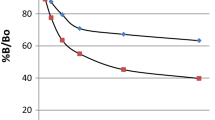Abstract
Nine sera with falsely elevated results in a TSH radioimmunoassay were studied. Sera dilution and gel filtration showed that the immunoreactive TSH was different from the standard and labeled TSH. It coeluted with the immunoglobulin fraction of the seru. Rabbit serum decreased or emphasized the artifact according to the dose. Falsely elevated results appeared only in radioimmunoassays using a double antibody method for the separation of free and bound labeled hormone. FSH, LH, and βHCG radioimmunoassays using the double antibody method underwent the same disturbance as the TSH assay in these patients. Our results suggest that the artifact may be due to the presence in certain human sera of anti-rabbit lgG antibodies, interfering in the radioimmunoassay by inhibition of the binding of first and second antibodies.
Similar content being viewed by others
References
Freychet P, Rosselin G, Dolais J (1969) Dosage radioimmunologique de l'hormone thyréotrope hypophysaire (TSH) dans le plasma humain. Le Press Med 77:13–16
Gendrel D, Feinstein MC, Grenier J, Roger M, Ingrand J, Chaussain JC, Canlorbe P, Job JC (1981) Falsely elevated serum thyrotropin in newborn infants: transfer from mother to infant of a factor interfering in the TSH radioimmunoassay. J Clin Endocrinol Metab 52:62–65
Gershengorn MC, Weintraub BD (1975) Thyrotropin induced hyperthyroidism caused by selective pituitary resistance to thyroid hormone: a new syndrome of “inappriopriate secretion of TSH”. J Clin Invest 56:633–642
Hedenborg G, Petterson J, Carlström A (1979) Heterophilic antibodies causing falsely raised thyroid stimulating hormone result. Lancet 2:755
Kourides IA, Weintraub BD, Maloof F (1978) Large molecular weight TSH-β: the sole immunoreactive form of TSH-β in certain human sera. J Clin Endocrinol Metab 47:24–33
Morgan CR, Sorenson RL, Cazarow A (1964) Studies of an inhibitor of the two antibody immunoassay system. Diabetes 13:1–5
Mornex R, Tommasi M, Cure M, Farcot J, Orgiazzi J, Rousset B (1972) Hyperthyroidie associée à un hypopituitarisme au cours de l'evolution d'une tumeur hypophysaire secretant TSH. Ann Endocrinol 33:390–396 (Paris)
Odell WD, Wilber JF, Paul WE (1965) Radioimmunoassay of thyrotropin in human serum. J Clin Endocrinol Metab 25:1179–1188
Sain A, Sham R, Singh A, Silver L (1979) Erroneous TSH RIA results due to interfering antibovine TSH antibodies. Am J Clin Pathol 71:540–542
Samols E, Bilkus D (1964) A comparison of insulin immunoassays. Proc Soc Exp Biol Med, 115:779–784
Schaison G, Thomopoulos P, Moulias R, Feinstein MC (1981) False hyperthyrotropinemia induced by heterophilic antibodies against rabbit serum. J Clin Endocrinol Metab 53:200–202
Soeldner JS, Slone D (1965) Critical variables in the radioimmunoassay of serum insulin using the double antibody technique. Diabetes, 14:771–779
Author information
Authors and Affiliations
Rights and permissions
About this article
Cite this article
Baulieu, J.I., Lepape, J., Baulieu, F. et al. Falsely elevated results of radioimmunoassays using double antibody method: Arguments for a third anti-rabbit IgG antibody present in certain human sera. Eur J Nucl Med 7, 121–126 (1982). https://doi.org/10.1007/BF00256399
Received:
Issue Date:
DOI: https://doi.org/10.1007/BF00256399




